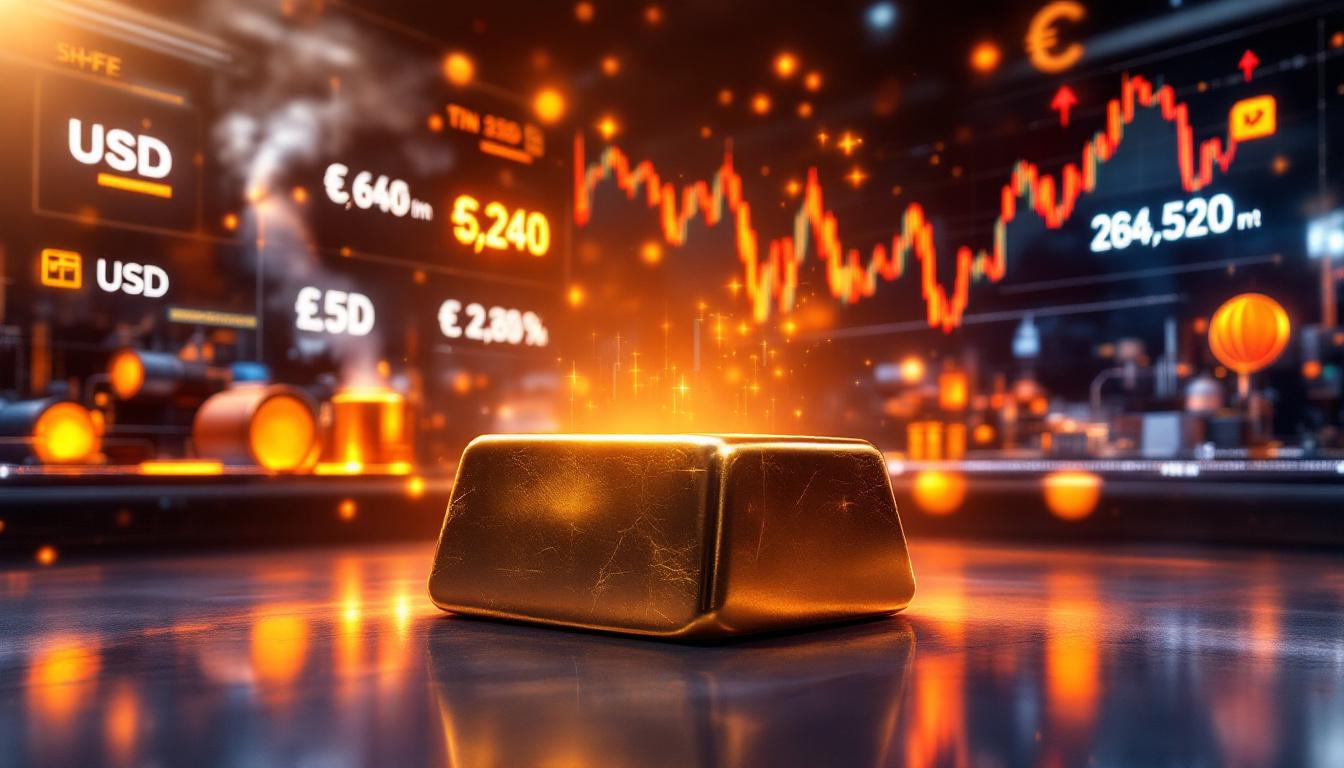What's Happening in the Silver Market Right Now?
Silver's Breakout from Containment Levels
Silver markets have been experiencing significant momentum in recent weeks, with prices breaking through previous containment levels that had capped the metal's ascent. As of mid-June 2025, silver faces notable resistance at the $36 level—a critical psychological and technical barrier that market participants are watching closely.
Technical analysis suggests silver has the potential to reach $38 in the near term, creating a pathway toward the important $40 threshold sooner than market structure had previously indicated. This accelerated timeline represents a fundamental shift in silver market dynamics that's catching many institutional traders off guard.
The breakout pattern follows silver's classic stair-step formation, where consolidation periods are followed by sharp upward movements. Current price action shows significantly higher trading volumes during upward movements compared to pullbacks—a bullish indicator suggesting strong buying pressure underneath.
"What we're witnessing isn't just technical trading—it's a fundamental reassessment of silver's value proposition in both monetary and industrial contexts," notes a recent analysis from a leading precious metals research firm.
The most revealing aspect of silver's recent price action is the significant unwind of gold‐silver ratio analysis trades occurring simultaneously. This ratio—which measures how many ounces of silver it takes to purchase one ounce of gold—has been contracting rapidly, falling from above 80:1 to approaching 70:1 in recent weeks.
The Silver Short Squeeze Phenomenon
A remarkable development underpinning silver's price surge is the triggering of large official short positions. These shorts are primarily related to gold-silver ratio trading strategies employed by institutional players, creating a cascading effect as positions are unwound.
The current market displays all the classic indicators of accelerated silver short squeeze dynamics:
- Rapid price increases on higher-than-average volume
- Expanding daily trading ranges with strong closes
- Diminishing selling pressure at previously established resistance levels
- Overnight price gaps that fail to fill during regular trading hours
- Substantial increases in futures open interest
This technical picture creates significant upward price pressure, as short sellers are forced to buy back positions at progressively higher levels. What makes the current situation particularly noteworthy is the dramatic shift in institutional positioning that's occurring simultaneously.
CME physical silver cover—which indicates the relationship between futures contracts and available physical metal—has been increasing substantially. This development highlights growing pressure on short positions and suggests a potential silver market squeeze in the physical market.
The convergence of these factors creates what analysts call a "perfect storm" for silver prices, where technical, fundamental, and positioning factors all align to drive prices higher in a self-reinforcing cycle.
How Is Gold Performing in Comparison to Silver?
Gold's Current Trading Range
While silver has been breaking out, gold has been displaying remarkable stability, contained within a trading range between $3,300 and $3,400. This relative steadiness demonstrates gold's different market characteristics compared to silver's heightened volatility.
An interesting dynamic currently supporting gold prices is sustained buying from Asian markets. According to market observers, "Asia is buying and higher stair steps are being anchored," creating solid foundational support despite the pressure from ratio trade unwinding.
This buying activity establishes a series of progressively higher support levels—a pattern technical analysts refer to as a "stair-step" formation. These levels provide crucial psychological and technical support that prevents significant downside moves and positions gold for potential end-of-quarter rallies.
Gold's resilience is particularly impressive considering:
- The headwinds created by ratio trade unwinding
- Seasonal patterns that typically show weakness in early summer
- The sharp outperformance of silver during the same period
- Institutional portfolio rebalancing ahead of quarter-end
Historical patterns suggest that this consolidation period for gold often precedes stronger moves, particularly as market attention shifts toward third-quarter positioning strategies and macroeconomic developments.
The Gold-Silver Ratio Trade Unwinding
The gold-silver ratio represents one of the oldest and most watched relationships in commodity markets. Currently, the unwinding of this ratio trade is weighing on gold's short-term performance while simultaneously boosting silver.
How the ratio trade works:
- Traders go long gold and short silver (or vice versa) based on historical ratio extremes
- When the ratio reaches statistical outliers (historically above 80:1 or below 40:1), positions are established
- As the ratio normalizes, profits are generated regardless of absolute price direction
- Institutional traders often employ significant leverage in these strategies
This relationship has profound implications for the silver vs gold performance. As one metals strategist explains, "When the ratio trade unwinds rapidly, it creates artificial selling pressure in gold that often presents buying opportunities for long-term investors."
The current unwinding appears more dramatic than typical cycles, suggesting institutional positioning had become significantly overextended. Market data indicates unusually large short positions in silver relative to historical norms, creating the conditions for the current squeeze.
Long-term implications of this unwinding include a potential recalibration of the "normal" trading range for the gold-silver ratio, which could establish lower ratio levels as the new baseline for future trading strategies.
What Do the Technical Indicators Reveal About Silver?
Silver Futures Open Interest Analysis
Silver futures open interest—the total number of outstanding contracts not yet settled—has experienced a significant ramp-up in recent weeks. This increase signals growing market participation and liquidity, typically associated with strong trending markets.
Current open interest levels exceed five-year averages by approximately 15%, indicating exceptional market engagement. More revealing than the absolute numbers is the composition of this open interest, with commercial positions showing unusual patterns compared to historical norms.
The CME physical silver cover metric—which measures the relationship between paper contracts and available physical metal—has been increasing substantially. This development has several important implications:
- Higher coverage ratios increase potential volatility during delivery periods
- Physical premiums over spot prices tend to expand as coverage increases
- Counterparty risk considerations become more prominent for contract holders
- Market vulnerability to delivery demands intensifies
A race to repatriate physical silver appears to be underway, with qualified depositories reporting accelerated withdrawal requests. This movement of metal typically precedes periods of heightened price volatility and premium expansion in physical markets.
Technical momentum indicators for silver, including the Relative Strength Index (RSI) and Moving Average Convergence Divergence (MACD), remain strong despite reaching levels that would typically signal overbought conditions. This divergence from normal technical behavior suggests extraordinary buying pressure that overwhelms traditional technical signals.
ETF Inflows and Physical Demand
One of the most compelling indicators of silver's current strength comes from ETF flows. The iShares Silver Trust (SLV), the largest silver ETF, has reported inflows exceeding 690 tons over just a four-week period—an exceptional rate of accumulation by historical standards.
Even more impressive is the total net inflow across all silver ETFs, which has reached 1,073 tons during the same period. To put this in perspective:
- This represents approximately 5% of annual global silver mine production
- The rate of accumulation exceeds the peak inflows seen during the 2020-2021 rally
- Physical delivery logistics are showing strain in major trading hubs
- Premiums for physical silver products are expanding globally
The pattern of these inflows reveals strong institutional accumulation occurring alongside retail buying. Unlike previous silver rallies that were primarily driven by retail investment, the current movement shows substantial professional money manager participation.
Retail versus institutional buying behavior can be differentiated by analyzing:
| Indicator | Retail Dominance | Institutional Dominance | Current Market |
|---|---|---|---|
| Time of day volume | After-hours spikes | Regular trading hours | Regular hours |
| Contract size | Small lots | Large block trades | Large blocks |
| Options activity | Out-of-money calls | At-money strategies | Mixed pattern |
| ETF vs. futures | ETF preference | Futures preference | Both strong |
| Physical premiums | High retail premiums | Wholesale premiums | Both elevated |
This balanced participation across market segments suggests a more sustainable price advance than movements driven primarily by one segment of the market.
Why Is Gold Open Interest Remaining Muted?
Contrasting Market Structures
Despite gold trading near all-time highs between $3,300 and $3,400, gold futures open interest has remained relatively flat. This divergence between price levels and market participation creates an unusual market structure that warrants attention.
The contrast between gold and silver market participation can be attributed to several factors:
- Ratio trade unwinding creating artificial selling pressure in gold futures
- Institutional positioning heavily favoring silver in current allocations
- Physical gold accumulation occurring outside futures markets
- Central bank influence bypassing traditional market mechanisms
The technical positioning in gold futures currently shows commercial traders (often representing mining companies and banks) maintaining higher-than-average short positions relative to price levels. This positioning typically precedes periods of heightened volatility as positions eventually normalize.
"The disparity between gold's price stability and muted open interest suggests accumulation is occurring through channels other than the futures markets—a potentially bullish indicator for longer-term price action," according to a recent bullion bank advisory.
The potential for catch-up movement in gold becomes more probable as silver's rally matures and ratio trades complete their unwinding cycle. Historical patterns suggest gold often experiences delayed but powerful moves following silver outperformance phases.
Seasonal Factors and Quarter-End Dynamics
Gold markets display well-documented seasonal patterns, with end-of-quarter periods often showing distinctive behavior. As we approach the end of the second quarter of 2025, these seasonal tendencies take on increased importance.
Historical analysis of Q2-Q3 transitions reveals:
- June typically represents a seasonal low point for gold prices
- July-August often see strengthening fundamentals and price appreciation
- Quarter-end institutional rebalancing can create temporary price distortions
- Position squaring ahead of major economic reports intensifies in final weeks
Institutional portfolio rebalancing significantly affects metals prices during these transition periods. As equity markets fluctuate, the precious metals allocation within balanced portfolios requires adjustment, creating predictable flow patterns in gold and silver markets.
The correlation with broader market cycles shows gold typically performs best during periods of:
- Increasing inflation expectations
- Decreasing real interest rates
- Heightened geopolitical uncertainty
- Currency market volatility
Current macroeconomic conditions align with several of these factors, suggesting the potential for seasonal strength to coincide with favorable fundamental drivers in the coming months.
What Are the Investment Implications of These Market Movements?
Short-Term Trading Opportunities
For active traders monitoring the precious metals markets, the current environment presents distinctive opportunities alongside elevated risks. Key price levels to monitor include:
For Silver:
- Initial resistance at $36.00-36.50
- Secondary resistance at $38.00-38.50
- Major psychological barrier at $40.00
- Support zone at $33.50-34.00
- Critical support at $32.00
For Gold:
- Resistance at $3,400-3,425
- Major resistance at $3,500
- Support at $3,300-3,320
- Critical support at $3,250
Risk management considerations are particularly important given the current volatility regime. Position sizing should be reduced compared to normal market conditions, with stop-loss orders placed at technical levels rather than arbitrary percentage moves.
Potential triggers for accelerated price movements include:
- Federal Reserve policy announcements
- Significant ETF flow changes
- Options expiration dynamics
- Geopolitical developments
- Quarterly economic data releases
Time horizons for different price targets vary considerably. Technical analysis suggests silver could reach the $38 level within 2-4 weeks, while the $40 threshold might require 6-8 weeks, assuming current momentum continues.
Longer-Term Outlook for Precious Metals
The fundamental drivers supporting continued strength in precious metals remain intact and may be strengthening. These include:
- Central bank policies maintaining negative real interest rates
- Continued expansion of global money supply
- Geopolitical fragmentation increasing monetary metal demand
- Industrial applications for silver expanding in green technology sectors
- Mine supply constraints limiting production growth
Macroeconomic factors currently exert significant influence on gold and silver markets. Most notable among these is the relationship between nominal interest rates, inflation expectations, and resulting real yields—which typically show inverse correlation with precious metals prices.
Central bank policies worldwide continue to emphasize financial stability over inflation control, creating an environment that historically benefits monetary metals. Official sector gold buying has remained robust, with central banks adding to reserves at the fastest pace in decades.
Supply-demand dynamics in physical markets show growing imbalances. Silver in particular faces:
- Industrial demand growth of approximately 5-7% annually
- Mining output constraints due to years of underinvestment
- Declining ore grades at major producers
- Limited recycling response to higher prices
For portfolio allocation considerations, the current environment suggests:
- Maintaining core positions in physical metals for wealth preservation
- Strategic use of mining equities for leverage to metal prices
- Consideration of specialized exposure to silver given current dynamics
- Prudent position sizing given elevated volatility
How Are Bullion Banks Responding to Market Conditions?
Bullion Bank Advisories and Market Guidance
Recent bullion bank recommendations have undergone notable shifts in tone and positioning advice. Traditional price targets have been revised upward, particularly for silver, as technical breakouts confirm changing market dynamics.
The historical context of bullion bank influence in precious metals markets provides important perspective. These institutions typically:
- Act as intermediaries between mining companies and end users
- Provide hedging services to commercial market participants
- Facilitate central bank transactions in gold markets
- Issue market guidance that often reflects their book positioning
Current advisories suggest potential for further short covering, particularly in silver markets where commercial short positions remain elevated relative to historical norms. This positioning creates ongoing vulnerability to price spikes during low-liquidity trading periods.
The market implications of bank positioning extend beyond short-term price movements. As major commercial shorts reduce their exposure, market structure changes can persist for extended periods, establishing new trading ranges and behavior patterns.
Physical Metal Movement and Delivery Trends
A particularly telling indicator of market stress is the acceleration in physical metal repatriation. Qualified depositories report increased withdrawal requests, with metal moving from exchange-registered inventories to private vaults and strategic storage facilities.
Delivery patterns on futures exchanges show increased standing for delivery relative to contract open interest. This trend typically precedes periods of premium expansion and can signal tightening physical supply conditions.
Premiums for physical metal versus paper contracts have been expanding, with particular stress evident in:
- 1,000-ounce silver bars used for industrial applications
- Kilo gold bars favored by Asian investors
- Smaller retail products experiencing manufacturing bottlenecks
The global flow of bullion between markets reveals interesting patterns, with:
- Western ETF outflows often finding destination in Asian markets
- Central bank acquisitions coming predominantly from large bar inventories
- New mine production quickly absorbed by industrial and investment demand
Inventory changes at major depositories provide objective confirmation of these flows. COMEX registered silver inventories have declined approximately 15% since the beginning of the year, while eligible inventories show smaller percentage changes but significant categorical reclassification.
FAQ About the Current Gold and Silver Markets
What is causing silver to outperform gold currently?
Silver's outperformance stems from several converging factors:
-
Ratio trade unwinding: As the gold-silver ratio normalizes from extended levels, mathematical reversion creates stronger percentage moves in silver.
-
Short squeeze dynamics: Large commercial short positions in silver futures are being forced to cover as prices rise through key technical levels.
-
Industrial demand strength: Silver's dual role as both monetary and industrial metal provides additional demand drivers beyond investment flows.
-
Market size differences: Silver's smaller market capitalization relative to gold means equivalent dollar flows produce larger percentage price movements.
-
Technical breakout momentum: Once key resistance levels were breached, momentum-based trading strategies added further buying pressure.
How significant are the recent ETF inflows for silver prices?
The recent 1,073-ton inflow across silver ETFs over a four-week period represents an extraordinary rate of accumulation:
- This equals approximately 34.5 million ounces of silver
- Represents roughly 5% of annual global mine production
- Exceeds the capacity of many refiners to deliver in such a timeframe
- Creates cascading effects on physical premiums worldwide
When compared to previous bull market phases, the current inflow rate exceeds even the peak periods of 2020-2021 when social media-driven investment surged. The sustainability of current inflow rates remains uncertain, but even a moderation to half the current pace would remain bullish for prices.
The impact on available physical supply is particularly significant given concurrent industrial demand strength and limited elastic supply response from mining operations. Unlike gold, which has significant above-ground inventories readily available for market needs, silver's industrial consumption creates tighter physical balances.
What technical levels should investors watch in both metals?
For silver, key resistance levels include:
- $36.00: Current resistance being tested
- $38.00: Next major technical and psychological barrier
- $40.00: Historical significant level representing major resistance
- $50.00: All-time high from 1980 and 2011 (inflation-adjusted would be substantially higher)
Support zones that should hold during healthy pullbacks:
- $33.50-34.00: Previous resistance now support
- $32.
Ready to Capitalise on Silver's Breakout Potential?
Stay ahead of the precious metals market with instant alerts on significant ASX discoveries through Discovery Alert's proprietary Discovery IQ model, turning complex market data into actionable investment insights. Visit the Discovery Alert discoveries page to understand why major mineral discoveries can lead to exceptional market returns and begin your 30-day free trial today.




